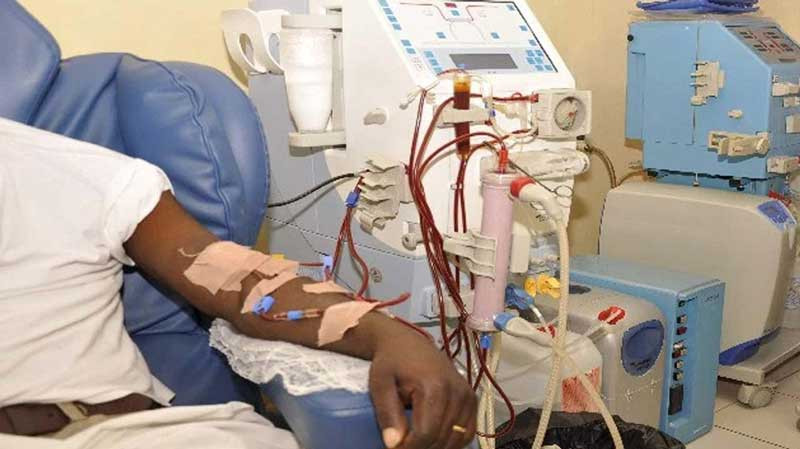
“I was not aware of what would befall me when doctors suggested I start dialysis in 2010,” said Nhamo Save* as he narrated his 13 year struggle with a kidney problem.
He had been diagnosed with a kidney ailment and doctors recommended dialysis.
“I religiously attended all my dialysis sessions since 2010 when I was going for three sessions per week,” he said.
After registering great improvement with the dialysis, Save has had his sessions reduced to once a week.
But he said the procedure is draining physically and financially.
Save registered at Parirenyatwa government hospital where dialysis sessions were pegged at US$80 compared to US$100 to US$400 charged at private health centres.
Government has since slashed fees to US$40 to subsidise the cost of treatment.
“Things have actually turned for the better as I am only going once a week and paying US$40 only,” he said.
- Manatsa widow burial tomorrow
- Parirenyatwa in fresh negligence storm
- Minor electrocuted at agric show
- Opinion: Corruption a threat to viability of health systems
Keep Reading
“I have been regarded as one of the best patients to respond to treatment as quite a number of patients I knew died.”
According to authorities at Parirenyatwa, the government hospital attends to nearly 50 patients every day for dialysis sessions.
Research shows that haemodialysis may cause itchy skin and muscle cramps.
Peritoneal dialysis can also put one at risk of developing peritonitis, an infection of the thin membrane that surrounds the abdomen.
Save said he has not been spared and has suffered some side effects including itching of the skin over the years.
Another patient on dialysis, Vasco Mukunangana has had the challenging condition known as End-Stage Renal Disease (ESRD) for the past 23 years.
“I just woke up one day with a swollen face and legs. A few days later the whole body had edema (swelling caused by too much fluid trapped in the body's tissues),” Mukunangana said.
At the time, Mukunangana said he was doing his Advanced Level studies.
“They tried treating me at the local clinic but nothing helped,” he said.
“A certain physician did a urinalysis test and discovered that my urine had traces of blood and protein and he diagnosed me with glomerulonephritis (inflammation and damage to the filtering part of the kidneys (glomerulus).
“He gave me some medication and another urinalysis test a couple of days later showed some improvement.”
Mukunangana was later referred to Parirenyatwa Hospital where he was admitted for more than a month.
“However, I also developed hypertension and was commenced on BP medication which also caused me to be generally fatigued,” he said.
“A few months later I was diagnosed with Advanced Renal Failure and I was hospitalised again.
“I had severe edema, U&Es (Urea and electrolytes) were shooting through the roof, I was nauseous and vomiting.
“They inserted a catheter and commenced me on haemodialysis. That was in the year 2000 and I have been on dialysis since then.”
Dialysis is a procedure to remove waste products and excess fluid from the blood when the kidneys stop working properly.
It often involves diverting blood to a machine to be cleaned.
Normally, the kidneys filter the blood, removing harmful waste products and excess fluid and turning these into urine to be passed out of the body.
Both types of dialysis can make a person feel exhausted.
This means that people can die while on dialysis if they do not have a kidney transplant, particularly older people and those with other health problems.
Someone who starts dialysis in their late 20s can expect to live for up to 20 years or longer, but adults over 75 may only survive for 2 to 3 years.
But survival rates of people on dialysis have improved over the past decade and are expected to continue improving in the future.
According to experts, patients need dialysis when they develop end stage kidney failure --usually by the time you lose about 85 to 90 percent of your kidney function
Usually, each haemodialysis treatment lasts about four hours and is done three times per week.
According to the Ministry of Health and Child Care, Zimbabwe records 1000 cases of kidney failure every year with only 700 accessing dialysis as a number cannot afford the lifesaving services.
“Kidney disease is also a silent killer, which affects the quality of life,” the ministry said.
“About half of people who have diabetes develop kidney damage hence it is important to keep control of blood sugar level.”
A kidney patient Bothwell Muti* said he was lucky to be told he needed once off treatment, though it cost him a fortune.
“The drug was expensive though family members chipped in and imported it from South Africa,” Muti said.
“After I was diagnosed, l felt like l would not overcome the disease and it was made worse when my fellow workmate succumbed to the same before the dialysis could be done.
“This left me with a fear that l will not succeed but with the help of counsellors at the hospital, I overcame it. They helped me a lot.”







